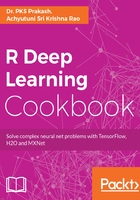
上QQ阅读APP看书,第一时间看更新
How to do it...
- H2O can be installed directly from CRAN with the dependency parameter TRUE to install all CRAN-related h2o dependencies. This command will install all the R dependencies required for the h2o package:
install.packages("h2o", dependencies = T)
- The following command is used to call the h2o package in the current R environment. The first-time execution of the h2o package will automatically download the JAR file before launching H2O, as shown in the following figure:
library(h2o)
localH2O = h2o.init()

Starting H 2O cluster
- The H2O cluster can be accessed using cluster ip and port information. The current H2O cluster is running on localhost at port 54321, as shown in the following screenshot:

H2O cluster running in the browser
Models in H2O can be developed interactively using a browser or scripting from R. H2O modeling is like creating a Jupyter Notebook but you create a flow with different operations such as importing data, splitting data, setting up a model, and scoring.